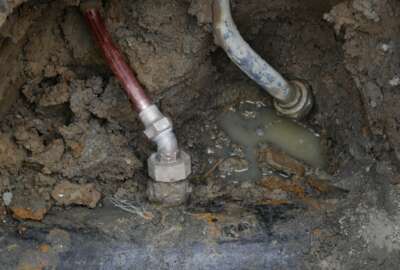The Nuclear Regulatory Commission is urged to improve its dirty bombs policy
"Some of these materials that currently have kind of weaker security requirements really could harm the public if they were misused," said Allison Bawden.
For years, the Government Accountability Office has called out the Nuclear Regulatory Commission for its policy on so-called dirty bombs — radiological threats from terrorists who obtain fission material. Auditors say NRC policy doesn’t take into account all of the potential consequences of dirty bombs. Details now from the GAO’s Director of Natural Resources and Environment, Allison Bawden.
Interview transcript:
Tom Temin You have been pulling on this thread for quite a number of years, as the report states; more than a dozen recommendations over the years. What is the issue with how the NRC treats this type of threat?
Allison Bawden Really, what we’re most concerned about is to have NRC consider the socioeconomic consequences of certain of these materials when they’re considering how to regulate their security. Some of these materials that currently have kind of weaker security requirements really could harm the public if they were misused. And we’re focused on ensuring that the security of those materials and the regulations around them is improved.
Tom Temin Right. So the consequences that are socioeconomic, that’s in addition to the fact that in the immediate sense, they could kill people, which is bad. And the NRC does take that into account. But they have other effects that might be longer term. Is that the issue?
Allison Bawden That’s right. These materials certainly could cause harm to human health and the environment if they were misused. But we’re also concerned about consequences such as the economic use of an area of a city or a county. We’re concerned about what could happen in an evacuation, which could be chaotic. And in past events like in Fukushima, we really saw harm from those kinds of evacuations.
Tom Temin Well, if these materials are already banned, then what’s the difference what they consider if they don’t want it in people’s hands in the first place?
Allison Bawden So the materials, they’re in broad use through industry and medicine and they have a lot of useful purposes. But if in the wrong hands, they could create some havoc. And what we are really looking to see is for NRC to tighten up regulation around certain materials, especially those that we’ve demonstrated we could get a hold of through fraudulent means.
Tom Temin Right. So these are things that are legal to have in the right circumstances, like an X-ray machine or some kind of a source of radiation for whatever.
Allison Bawden Sure. So a lot of these are used, for example, in checking for weld quality or in the oil and gas industry. Some of them are even road mobile. They can be driven around on trucks.
Tom Temin And in your report in the very beginning, kind of the summary, you mentioned the National Nuclear Security Administration and the [Department of Homeland Security] unit called Countering Weapons of Mass Destruction Office. They both also have a hand in regulating these things. And you point out they are more comprehensive in how they consider these. If that’s the case, what difference does it make if NRC isn’t that comprehensive?
Allison Bawden The NRC is responsible for the regulatory framework and setting the security requirements for these materials and how the individuals or organizations that are licensed to have them need to protect them so that they stay in regulatory control. The National Nuclear Security Administration does a lot of work to help remove sources that the users no longer want to ensure that they don’t become abandoned, which could lead to somebody finding them and misusing them. And the Office of Countering Weapons of Mass Destruction supports local and state law enforcement in equipping them and training them to detect these materials in the event of an incident and hopefully support prevention of something bad happening. So we’re looking to to ensure that these organizations, these federal agencies, are synced up with with how they consider the consequences of misuse.
Tom Temin We’re speaking with Allison Bawden. She is director of natural resources and environment at the Government Accountability Office. What could the NRC potentially do differently if it did take into account the socioeconomic factors and not just the immediate danger to life and health at that moment? How might the rules look differently than if they did take that into account?
Allison Bawden So there are really a couple of things that we’ve recommended NRC consider. The first is really just that considering socioeconomic consequences in the regulatory framework for securing these materials. And if that were done, the NRC would likely track these materials in its existing national source tracking system, which would help identify materials and how they’re sold, how they’re resold and ensure some security around them. It might also result in additional security protocols for licensees, such as ensuring that those with access to those materials are escorted or have background checks, that sort of thing. At this point though, we’ve made those recommendations before and NRC has not taken action. So in this recent work, we’re actually elevating these recommendations to the Congress, for Congress to consider directing NRC to take action.
Tom Temin Right. So members of Congress must have been concerned about this because that’s where GAO gets its impetus to do a report in the first place.
Allison Bawden Yes, that’s right.
Tom Temin What are the specific recommendations you’ve made and what has NRC said about them, or do they just ignore you?
Allison Bawden We have specifically made recommendations for NRC to consider incorporating socioeconomic consequences into its decision making for security requirements setting, particularly with respect to radiological materials. And that NRC track a category of sources known as category three — they’re a bit smaller in quantity, but still are significant in terms of their effect if they were misused — that NRC track those sources in its national source tracking system. NRC did proceed with a rulemaking back in 2022 that, if it had passed, would have implemented some of our recommendations. But in March of 2024, there was a 2-2 vote on that rule. And so it did not go forward. At the moment, as a result of that, NRC does not have actions ongoing to implement our recommendations, and that’s why we are elevating these to the Congress for consideration.
Tom Temin This might not have been in the report – I didn’t see it – but is there perhaps industry pushback against that? Because as you say, these do have legitimate materials, don’t always fall in the hands of terrorists, but they could just be mishandled by people that should know better but don’t do better. Could that be part of the problem? Because it sounds like there’s a cost implication to industry should these rules get tightened up.
Allison Bawden There is a small cost to industry and what we have identified is an $11 million cost over ten years to implement the tracking recommendation, which really seems like a small amount when you consider the potential cost of an adverse event using these materials. For example, there was a radiological incident, completely an accident, that happened at a hospital at the University of Washington several years ago, where a very small quantity of material was released and it cost the government about $150 million to clean up that facility. And it took the facility out of use for medical research purposes for a number of years. So when you compare the cost of that $11 million over ten year implementation and the cost of cleaning things up, it really is sort of a no-brainer in our perspective.
Tom Temin Right. So in other words, the results of mishandling or misuse or something going wrong with a, I don’t know, a $50,000 machine that has a radiological source in it could end up costing untold millions of dollars if that thing inside there escapes.
Allison Bawden That’s right.
Tom Temin All right. So what happens next? You kind of put the ball in Congress’s court at this point. Less so than in the NRC’s court.
Allison Bawden That’s right. And of course, we’ll continue to follow whether there is action to implement the recommendations that we’ve made in the past and continue to have conversations about this with anyone who wants to talk with us.
Tom Temin But the key here, I think, is that there have been incidents that did cost real money based on those consequences of economic use of facilities and so forth. This is not theoretical.
Allison Bawden That’s right. And there have also been accidents that have been avoided. So, for example, a few years back in Houston, there was a police officer who was equipped with a personal radiological detection device provided through the Department of Homeland Security’s programs. And in driving by a particular place on the highway a couple of days in a row, the alarm kept going off and that police officer took it upon himself to investigate and determined that a radiological source had shown up in a scrap yard. And it was alarming. It shouldn’t have been there. And if that source – it actually turned out to be, I think, three or four sources – if those sources had been dispersed through crushing or the things that happened in the scrap yard that really could have created a very significant incident. So that was, we got lucky that time.
Copyright © 2024 Federal News Network. All rights reserved. This website is not intended for users located within the European Economic Area.
Tom Temin is host of the Federal Drive and has been providing insight on federal technology and management issues for more than 30 years.
Follow @tteminWFED






